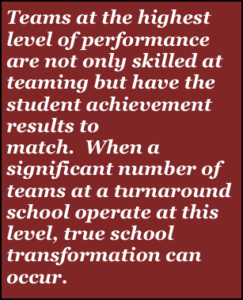Collaboration in a Turnaround School
Teacher collaboration is one of the most important—and untapped—components of a turnaround school. As far as collaboration goes, school leaders have discerned well—we value people working together. School leaders have also made decisions to encourage collaboration by organizing teachers into Professional Learning Communities or Communities of Learners or other names that designate teachers working as part of a team. However, the effectiveness of teams in turnaround schools often varies greatly from school to school and even team to team. As you read the description of the collaboration spectrum below, see if you can identify the team members at your school.
On one end of the spectrum are teachers who do not see the value in teaming and would rather not spend their time in team meetings. Regardless of their effectiveness, they believe that they are better served by working alone. They often believe that teaming takes away from their personal planning and is generally a waste of their time. Frequently, when required to be part of a team, they exhibit poor collaborative skills.
Further along the spectrum are teachers who enjoy being part of a team. They tend to have good interpersonal skills, work well together and share well. When asked, they believe that they are effective and in many ways, they are. However, they often have not been exposed to a set of formal team fundamentals that allow them to perform at a more effective level.

Teachers that function at the next level are those that are committed to a formal definition of teaming, practice collaboration diligently and constantly receive feedback and follow up to improve both their technical and their interpersonal skills.
They follow explicit protocols for both planning and reflection—including skills in root cause analysis—and continuously improve upon them.
Teams at the highest level of performance are not only skilled at teaming but have the student achievement results to match. When a significant number of teams at a turnaround school operate at this level, true school transformation can occur.
I believe that much of the variance that exists in teams in turnaround schools can be closely contributed to the lack of details describing exactly what collaboration means, on what information teachers should be collaborating, and how they should be doing it.
Collaboration is One of the Key Drivers of School Transformation
In my previous article on School Culture, I made the case that most people within an organization truly want to do what the organization wants them to do. Indeed, most teachers in turnaround schools value collaboration and want to do it well.
When school leaders and teachers purposefully pursue a common definition of collaboration and engage in an ongoing process to refine their skills, we can capitalize on one of the key drivers of school transformation. In my next article I will explore a definition of a team and its implication for schools.
Mark Rolewski has assisted schools and school districts in designing and implementing successful turnaround initiatives for over 19 years. Mark has assisted with school turnaround in many districts and schools including those in New York City, Hartford, New Orleans, Memphis, Kansas City and Los Angeles. He is widely sought after by schools and school districts to speak about and assist with turnaround initiatives. This is the fourth installment of an ongoing series that outlines many of the components of a turnaround initiative.
For additional information, please visit Mark’s webpage.
Click here if you would like to sign up to receive future articles via email.